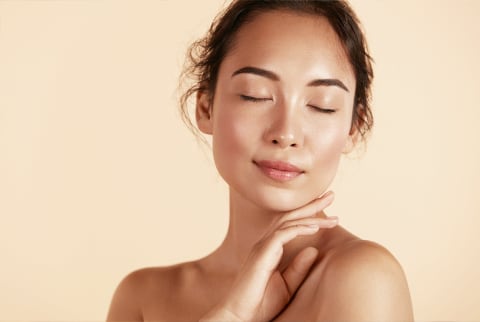This Ayurvedic Facial Massage Brightens Your Skin & Reduces Toxins


For thousands of years, cultures around the world have relied on massage techniques to promote whole-body healing—think moving lymph fluid, increasing circulation, aiding detoxification, and more. Given these benefits, it's really no wonder these modalities have withstood the test of time; you might opt for a gentle at-home facial versus full-on bodywork, but still, you pay homage to ancient healing techniques with each scrape across your jawline.
But each culture follows slightly different steps. For example, "In Ayurveda, the art of massage is called Abhyanga," says Michelle Ranavat, Ayurvedic beauty expert and founder of her namesake brand, Ranavat. Below, she'll teach you how to perform a lifting, de-puffing, detoxifying routine for your face:
Grab the right tools.
Like any facial massage, you need to grab an oil to ensure you have enough slip (pulling and tugging at the delicate facial skin is a recipe for wrinkles down the line). "When selecting an oil, use a tri-doshic oil, meaning it works with all skin types," Ranavat explains. Bonus points if your blend also includes beloved Ayurvedic extracts, like turmeric, amla, etc.
Sesame oil is typically a safe bet for all doshas, which is why she used it as the base of her gorgeous Brightening Saffron Serum (saffron, too, is an Ayurvedic elixir known for its antioxidant, antimicrobial, and anti-inflammatory properties).
You can use your own two hands for Abhyanga, but if you do opt for a tool, make sure to use one with pure kansa, which helps detoxify the skin, says Ranavat. "In Ayurveda, there is no facial tool more sacred or celebrated than the Kansa Wand," she notes. "The word kansa, derived from Sanskrit—the language of ancient India—is a mixture of copper and tin and is often referred to as the 'bell metal,' a metal selected for its purification and balancing benefits. It is anti-inflammatory and adds a calming presence to the skin."
Massage.
Tools at the ready? Below, find Ranavat's step-by-step instructions:
- To prep, apply a few drops of oil to your skin.
- Hold the wand (or your two fingers, if you're not using tools) at the center of your chin. Massage the wand in circular motions, warming the oil as you follow the jawline and end at the bottom of the ear. Repeat 4 to 5 times and switch sides.
- Then hold the wand at the corner of your mouth and massage in circular motions up the natural lines of your cheekbones. Stop at the center of your ear, repeating 4 to 5 times before switching sides.
- Finally, end your treatment by making gentle figure-eight motions around the temples of your eyes, forehead, and above the eyebrows.
No need to apply ample pressure here: "By applying slight pressure with the Kansa Wand, the treatment will be effective and gentle for optimal skin results in the form of firmer, sculpted, and detoxified skin," says Ranavat.
If you need a visual, feel free to check out Ranavat's tutorial video.
Rinse the residue.
As you massage with pure kansa, you may notice a slightly gray residue appear on your skin—according to Ranavat, that's a good thing! As the material draws out inflammation and interacts with the oils on your skin, it creates a reaction that can result in a light gray substance.
"The kansa wand will oxidize the oils on the skin as it purifies," Ranavat adds. "This residue washes off easily and can serve as an indicator to how balanced your skin is." Simply rinse your face with a gentle cleanser and cloth post-massage, and always follow up with a nourishing face cream to lock in the hydration.
The takeaway.
Regular facial massage is top-notch for promoting tighter, firmer, more lifted skin, but if you follow these ancient Ayurvedic guidelines, you can further detoxify your complexion. Kansa is a sacred material that has been beloved for over 5,000 years thanks to its skin-healing abilities, so it's certainly a worthy addition to your routine. No tool? No problem: See here for a full-body abhyanga tutorial using nothing but your fingertips.

Jamie Schneider is the Beauty Editor at mindbodygreen. She has a B.A. in Organizational Studies and English from the University of Michigan, and her work has appeared in Coveteur, The Chill Times, and more. In her role at mbg, she reports on everything from the top beauty industry trends, to the gut-skin connection and the microbiome, to the latest expert makeup hacks. She currently lives in Brooklyn, New York.